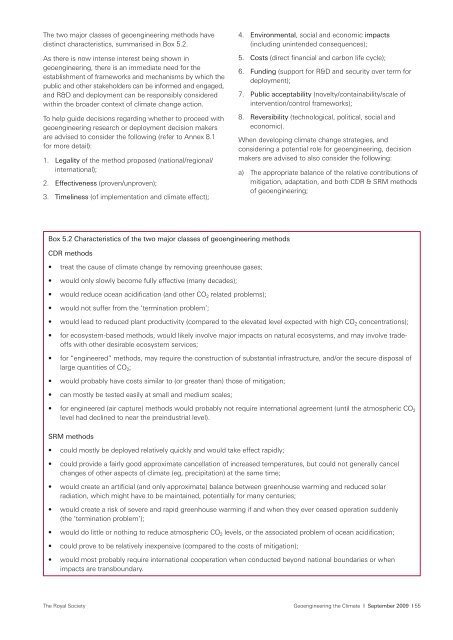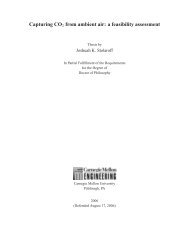Royal Society - David Keith
Royal Society - David Keith
Royal Society - David Keith
Create successful ePaper yourself
Turn your PDF publications into a flip-book with our unique Google optimized e-Paper software.
The two major classes of geoengineering methods have<br />
distinct characteristics, summarised in Box 5.2.<br />
As there is now intense interest being shown in<br />
geoengineering, there is an immediate need for the<br />
establishment of frameworks and mechanisms by which the<br />
public and other stakeholders can be informed and engaged,<br />
and R&D and deployment can be responsibly considered<br />
within the broader context of climate change action.<br />
To help guide decisions regarding whether to proceed with<br />
geoengineering research or deployment decision makers<br />
are advised to consider the following (refer to Annex 8.1<br />
for more detail):<br />
1. Legality of the method proposed (national/regional/<br />
international);<br />
2. Effectiveness (proven/unproven);<br />
3. Timeliness (of implementation and climate effect);<br />
4. Environmental, social and economic impacts<br />
(including unintended consequences);<br />
5. Costs (direct financial and carbon life cycle);<br />
6. Funding (support for R&D and security over term for<br />
deployment);<br />
7. Public acceptability (novelty/containability/scale of<br />
intervention/control frameworks);<br />
8. Reversibility (technological, political, social and<br />
economic).<br />
When developing climate change strategies, and<br />
considering a potential role for geoengineering, decision<br />
makers are advised to also consider the following:<br />
a) The appropriate balance of the relative contributions of<br />
mitigation, adaptation, and both CDR & SRM methods<br />
of geoengineering;<br />
Box 5.2 Characteristics of the two major classes of geoengineering methods<br />
CDR methods<br />
• treat the cause of climate change by removing greenhouse gases;<br />
• would only slowly become fully effective (many decades);<br />
• would reduce ocean acidification (and other CO2 related problems);<br />
• would not suffer from the ‘termination problem’;<br />
• would lead to reduced plant productivity (compared to the elevated level expected with high CO2 concentrations);<br />
• for ecosystem-based methods, would likely involve major impacts on natural ecosystems, and may involve tradeoffs<br />
with other desirable ecosystem services;<br />
• for “engineered” methods, may require the construction of substantial infrastructure, and/or the secure disposal of<br />
large quantities of CO 2 ;<br />
• would probably have costs similar to (or greater than) those of mitigation;<br />
• can mostly be tested easily at small and medium scales;<br />
• for engineered (air capture) methods would probably not require international agreement (until the atmospheric CO2<br />
level had declined to near the preindustrial level).<br />
SRM methods<br />
• could mostly be deployed relatively quickly and would take effect rapidly;<br />
• could provide a fairly good approximate cancellation of increased temperatures, but could not generally cancel<br />
changes of other aspects of climate (eg, precipitation) at the same time;<br />
• would create an artificial (and only approximate) balance between greenhouse warming and reduced solar<br />
radiation, which might have to be maintained, potentially for many centuries;<br />
• would create a risk of severe and rapid greenhouse warming if and when they ever ceased operation suddenly<br />
(the ‘termination problem’);<br />
• would do little or nothing to reduce atmospheric CO2 levels, or the associated problem of ocean acidification;<br />
• could prove to be relatively inexpensive (compared to the costs of mitigation);<br />
• would most probably require international cooperation when conducted beyond national boundaries or when<br />
impacts are transboundary.<br />
The <strong>Royal</strong> <strong>Society</strong><br />
Geoengineering the Climate I September 2009 I 55








